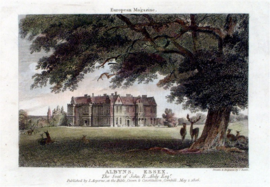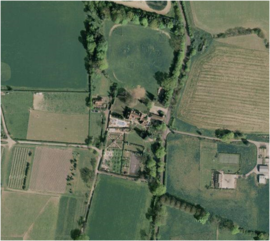MRP: Buildings
Contents
Buildings
LONDON
The Corner or Old Corner (?of Old Bailey), London
Elizabeth Dalyson's lodgings, Throgmorton Street, London
Sir George Smith's house, Throgmorton Street, London
Grays Inn Chambers, London
ENVIRONS OF LONDON
William Ryder's house, Bethnal Green
St. John Street, Clerkenwell (Sir Maximilian Dallison)
St. John Street, Clerkenwell (Lady Oxenden)
DENBIGHSHIRE
Myddleton family, Chirk Castle, Denbighshire
ESSEX
Sir Robert Abdy's house, Albyns, Stapleford Abott, Essex
KENT
Dixwell, later Oxenden family house, Broome Park, Kent
Oxenden family house, Deane, Deane House, or Deane Park, Kent
Stanley, later Dalyson house, Hamptons, Kent
Henry Oxinden's house, Maydekin, Barham, Kent
Richard Master's house, East Langdon, Kent
Sir Thomas Piers' house, Stonepitt, Kent
Thomas Stanley's house, Plaxtol, Kent
James Master's house, Yotes Court, Kent
DENBIGHSHIRE
Myddleton family, Chirk Castle, Denbighshire
Sources
ESSEX
Sir Robert Abdy's house, Albyns, Stapleford Abott, Essex
Sir Robert Abdy purchased the manor and manor house of Albyns in 1654 from Baron Coleraine for £5,360. The house was demolished in 1954, but at Abdy's time was what the VCH: Essex describes as a "very fine manor house," which incorporated parts of a smaller, earlier C16th house. A survey of the building exists, carried out by the Royal Commission on Historical Monuments, 1920. The house was brick-built, enclosing a courtyard on four sides. The VCH, drawing on the RCHM, describes it as "entirely of the King James Gothic," with mullioned and transomed windows, and two story bays on three sides. There was a long gallery on the first floor of the west wing, with fine panelling and an elaborate chimney. The quality of fittings and plasterwork was high. "The shields in the spandrels of the older fireplaces were painted with the date 1654 and the initials A B K (for Robert and Katherine Abdy) and the panelling bore the arms of Abdy and Gayre." There is a detailed estate map of Albyns from the period of its acquisition by Sir Robert Abdy, the work of John Kersey. "It shows the layout of the grounds with stables and a dovehouse to the east of the mansion and a straight avenue leading south from the main entrance."Sources
XXXX, A new display of the beauties of England, 1st vol., 3rd ed. (London, 1776), p.39
Royal Commission on Historical Monuments (XXXX, 1920), p. ?
Powell, W.R., 'Stapleford Abbots: Introduction', A History of the County of Essex: Volume 4: Ongar Hundred (1956), pp. 222-223
Powell, W.R., A History of the County of Essex: Volume 4: Ongar Hundred (1956), plan of Albyns, Stapleford Abbots, from an estate map of 1654 (Essex Record Office D/DC 27/1121), p. 226
Essex Archives: D/DAy Records of the Abdy family of Albyn, Stapleford Abbots and Felix Hall, Kelvedon
Essex Archives: D/Day E3 Rents, Manor of Albyns, Garnish hall and Barndon Hall, c. 1640
KENT
Oxenden family house, Deane, Deane House, or Deane Park, Kent
Deane or Deane House was built in 15XX by XXXX. Henry Oxinden of Barham gives a brief building history in a short personal memoire. XXXX.
Badeslade illustrated the house, outhouses and formal gardens in an engraving which was published in John Harris’ The history of Kent in 1719.
Just over one hundred years later Neale remarked that “Deane Park is situated in a beautifully wooded valley, at the southern extremity of the parish of Wingham, about two miles from Lee Priory, and about the same distance from Goodnestone Park. He described it as a “venerable mansion, which is large and noble in its appearance.” The engraving he illustrated his entry on Deane Park he described as being taken from near the end of a “very fine old avenue of horse chesnuts.” A less mature tree lined avenue can be seen on Badeslade’s 1719 engraving of the house and gardens. A painting attributed to Charles Tattershall/Dodd and dated 1840 appears to show a circular carriage drive at the front of the house, which is not visible in Neale’ s engraved illustration and which was also absent from Badeslade’s engraving. Presumably this was a nineteenth century addition.
The building was three stories in height with high pointed gables. Neale suggested that the gables “appear to have originally been ornamented with small cylindrical shafts on the bases and points” but that they had now been destroyed by time. The mid-sixteenth century character of the building was still visible, most of the windows having “ancient mullions and transoms to divide the lights.” Some of the windows had painted glass displaying the arms of the family. There was a small sun dial over the front centre entrance. The building appeared substantially unaltered and retained a “stately appearance.” The grounds had been modified in the mid-seventeenth century, with some limited internal alterations.
Sources
Sir Thomas Piers' house, Stonepitt, Kent
Stonepitts (Stonepit, Stone Pit(t)(s)) was the manor house and residence of Sir Thomas Piers, Bt., the husband of Jane Oxenden, sister to Sir George and Sir Henry Oxenden, and to Elizabeth Dalyson. Hasted describes the house as dating from the reign of Elizabeth I and lying on poor quality soil, near Seal in north Kent. According to Hasted it became the property of Lawrence Piers of Westfield, Sussex, through marriage, and was passed to his son Thomas, later Sir Thomas Piers. In the south chancel of the parish church of Seal(e) there is a memorial to Sir Thomas Piers. Situated in the parish of Seale, it is in the diocese of Rochester and deanery of Malling. The property still exists, described in an English Heritage Grade II listing as ‘Stonepitts Manor House.’Sources
Hasted, Edward, 'Parishes: Seale', The History and Topographical Survey of the County of Kent: Volume 3 (1797), pp. 51-59
James Master's house, Yotes Court, Kent
James Master built Yotes Court in 1659, pulling down the previous mansion on the site, which had been the property of his step-father Sir Thomas Walsingham. In 1828 the property was described in some detail: “It consists of two stories surmounted by a high roof, with dormer windows, and is built of brick, with stone quoins and dressings: a small Corinthian porch opens to a Hall fifty-eight feet long by nineteen feet wide; having on the right, a Dining-Room, and on the left of the entrance, a Drawing-room. The whole of the grounds comprise about one thousand acres, of which the house, garden, and shrubberies, immediately adjoining, occupy six acres; the water in the park, from whence all the ponds in the neighbourhood are fed, extends over five or six acres, and there are about three hundred acres of cover. From the principal entrance to Yotes Court, in the Mereworth Road to Forge Gate, is a beautiful drive of nearly a mile.” An 1889 Order of the Land Commissioners schedules the Yotes Court estate, then owned by Viscount Torrington, and describes it comrpising nine hundred and forty acres, which the schedule broke into thirteen blocks, with land in both the parishes of Mereworth and West Peckham. However, no information is available on the size of the estate at the time of the construction of Yotes Court.
Sources
Text
‘The expense-book of James Master, pt. II, A.D. 1655-57, Mrs. Max Dalison transcribed, Canon Scott Robertson, Archaeologica Cantiania, vol. 16 (London, 1886)
‘Expense-book of James Master, pt. III, A.D. 1658-1663, Mrs. Max Dalison transcribed, Canon Scott Robertson, Archaeologica Cantiania, vol. 17 (London, XXXX), pp. 321-352
‘Expense-book of James Master, Esq. Pt. IV’, Archaeologica Cantiania, vol. 18 (London, XXXX)
'Scheduling of Yotes Court Estate' (XXXX, 1889)
‘The life of James Master,’Archaeologica Cantiana, vol. 18 (London, XXXX), pp.157-168
J.P. Neale, Views of the seats of noblemen and gentlemen, in England, Wales, Scotland, and Ireland , vol. 4 (London, 1828), p. unnumbered
Images
'Yotes Court' in J.P. Neale, Views of the seats of noblemen and gentlemen, in England, Wales, Scotland, and Ireland , vol. 4 (London, 1828), p. unnumbered
The Hamptons, Kent
This house was leased by Thomas Stanley to Elizabeth Dalyson, following the signing of a marriage contract between his daughter, Frances, and Elizabeth's son, Maximilian. The property had come into the Stanley family through the marriage of Thomas' father, XXXX Stanley, to XXXX of the Hamptons, Kent. Nothing is known of the building history.
Edward Hasted wrote in 1798: “The seat of Hamptons, now almost in ruins, stands near the east side of this stream, in a wild gloomy situation, and at a small distance, that of Oxenhoath, an antient brick building, situated on a rise of ground, having a most extensive prospect over the Weald, and again to the hills north-eastward, the ground about it is finely wooded, and is the greatest part of it exceeding rich pasture.”
The original Hamptons was apparently destroyed by fire in 1883. Another building, also titled Hamptons in West Peckham has been listed by English Heritage as Grade II. The listing states that this house was being built in 1813.
No surviving image or plan of the house has been found.
Sources
Hasted, Edward : 'Parishes: West Peckham', The History and Topographical Survey of the County of Kent: Volume 5 (1798), pp. 56-70
Hull, Felix, Guide to the Kent archives (XXXX, 1958), p. 174
http://www.britishlistedbuildings.co.uk/en-178964-hamptons-west-peckham, viewed 18/08/11
‘Letters of Thomas Stanley of Hamptons’ in Archaeologia cantiana, vol. 17 (London, 1887)


